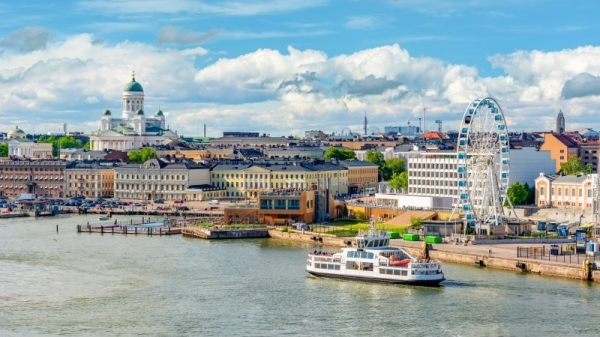Sustainable construction: lessons from Helsinki

Helsinki has been using competitions to encourage sustainable construction and is leading the way in reducing the sector’s carbon impact, write Tomi Rantala and Kaisa-Reeta Koskinen.
Carbon emissions associated with the construction of buildings – also known as “embodied carbon” – are on the rise, yet remain overlooked.
Helsinki’s ambition to speed up carbon neutrality and move to a circular economy puts green buildings at the centre of our climate strategy.
Making sure emissions-related requirements are integrated into the city’s budget, the Helsinki City Board recently approved the “Carbon Neutral Helsinki Action Plan” focused on emissions reduction.
The city wants to set requirements for all buildings’ carbon impact on the environment and wanted to test this idea and see what minimum requirements could look like.
A recent city competition, ‘Verkkosaaren vähähiilinen viherkortteli’, asked developers and their design teams for ideas on how to create a low-carbon, energy-efficient and high-technical standard city block. The block needs to include both housing and commercial spaces and be in line with the target.
It was emphasized to the participants that high-quality architecture was not enough – to achieve climate goals, you also need to be ambitious. With this in mind, 50% of the competition score went to the architectural design, and the other 50% to the carbon footprint and other ‘green factors’, including energy intensity.
By setting up this competition, Helsinki wanted developers to come up with innovative ideas which they could use for future projects to tackle the carbon impact of buildings more comprehensively.
While the city has measures in place to increase wood usage in construction, there have been challenges, namely that there are not enough market operators in the field. However, as energy efficiency improves, construction methods and material choices become increasingly important.
The winner, ‘Grün in der Mitte’, comprehensively took the competition’s goals into account, putting forward a clever design which incorporates wood and lower-emissions concrete.
The block will have different types of green roofs, a large yard in proportion to the buildings, a well-thought-out water cycle and heating solutions, and a parking solution that reduces the need for concrete.
Two other proposals, “Hiiling” and “Verkkosaaren puuverso”, received honourable mentions from the city – and they were so impressive as runners-up that they were given another plot in Helsinki to develop their projects.
The architectural solutions of the plan and successful material choices together form a whole with a small carbon footprint, which is more than the sum of its parts. While all the proposals’ carbon footprint and energy intensity values were much lower than the usual values put forward to the City of Helsinki, Grün in der Mitte clearly came on top.
Without concrete measures, like carbon footprint calculations, it is very difficult to compare proposals. That’s why this competition was so important.
When clear goals are set, the competition shows that if developers want to become more ambitious, they can do it. That’s why we need to continue making big moves, not small pilots.
The proposals’ carbon footprint varied between 5.83-13.67 kgCO2e/m2/a (with a 50-year calculation period of 291.5 kgCO2e/m2 – 683.5 kgCO2e/m2). To give the reader a better idea, the normal value Helsinki was receiving prior to this competition was 16 kgCO2e/m2/a.
As for the energy intensity, values ranged between 27-70 kWh/m2/a, while the national requirement for new buildings is <90 kWh/m2/a. Grün in der Mitte came on top with a proposal of reducing the carbon impact of the building to 8,46CO2e/m2/a and an energy consumption of 31 kWh/m2/a.
Moving forward, Helsinki wants to run future competitions to continue motivating developers to be more innovative and environmentally friendly. You should not be afraid to fail, even if there are challenges – you have to try.
For this competition, the 12 proposals received were very impressive and we hope to receive proposals of similar quality in future – and that we are able to develop criteria which make them easier to compare.
For other cities and developers aiming to significantly reduce the carbon impact of their buildings, Helsinki offers several observations and suggestions:
- Energy intensity can be reduced by resorting to geothermal heating and cooling, waste heat recovery, considering heat loads in structural solutions, optimizing the building technology, or off-site solar electricity.
- Strategies to reduce buildings’ carbon impacts include using wood as frame material, avoiding concrete structures or resorting to low-emission concrete as well as using low-carbon materials or old concrete frame as a basis for a new building.
- The ‘greenest’ proposals we received were ones that considered a wider range of solutions relating to circular economy and natural diversity and local species such as green roofs and the nutrient cycle
With Europe fighting an energy crisis, supply chain disruptions and a cost-of-living crisis, cities can play a pivotal role in building back a stronger, greener economy – and the built environment is an important sector to prioritise.
By taking a life-cycle approach when making decisions about construction – and focusing on circular economy solutions by establishing criteria in future – Helsinki is leading the way in challenging the construction sector and significantly reducing its carbon impact.



